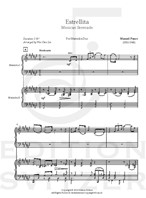
Estrellita
Composer: Manuel Ponce
Instrument: Marimba Duo
Level: Advanced
Published: 2016
Price: €16.00
Item details
-
Description +
-
Duration: 6 min.
Manuel Ponce (1882 – 1948) is a Mexican composer, whose compositions draw on traditional Mexican harmonies and folk tunes. In 1912, Ponce composed “Estrellita”, which became his most famous work, for voice and piano. In 1927, violinist Jascha Heifetz arranged this piece for violin and piano, which is listed on his concert program in Mexico during his 1927 world concert tour. Estrellita later became well-known to American audiences after its US premiere by Heifetz in New York, 1928.
This new arrangement for marimba duo does not attempt to imitate any other instrument. Instead, the performers are encouraged to show the distinctive timbre of the marimba and to present the cultural background of Central American music.
-
-
Instrumentation +
-
Two Marimbas (5-octave)
-
-
Watch+
-
About the composer +
-
Manuel María Ponce Cuéllar (8 December 1882 – 24 April 1948) was a Mexican composer active in the 20th century. His work as a composer, music educator and scholar of Mexican music connected the concert scene with a usually forgotten tradition of popular song and Mexican folklore. Many of his compositions are strongly influenced by the harmonies and form of traditional songs
-
-
Reviews +
-
Review (Percussive Notes, June 2020)
“Estrellita” was written in 1912 by Mexican composer Manuel Ponce. Originally scored for voice and piano, it is considered one of his most famous works and has been adapted for a variety of instrument combinations. According to arranger and percussionist Wei-Chen Lin, this setting for marimba duo aims “to show the distinctive timbre of the marimba and to present the cultural background of Central American music.” It is most suitable for an upper-level undergraduate recital or showcase performance.
This beautiful arrangement presents several opportunities for the performers to explore expressivity, interpretation, and communication in a chamber environment. The vocal line appears exclusively in the marimba one part and requires only two-mallet technique from the player. In contrast, the marimba two part is comprised of the harmonic content across a wide range of the instrument and utilizes extensive four-mallet technique throughout. It is important that both players have a firm grasp of sequential eighth-note triplet and syncopated sixteenth-note figures, as these are used frequently in the piece. Furthermore,double stops are prevalent in both parts, whether it is between hands or as double vertical strokes. While these are made more manageable due to the slower nature of the piece, the key signature and plethora of accidentals creates the added challenge of figures across both manuals of the keyboard.
At approximately three minutes in length, Wei-Chen Lin’s setting of “Estrellita” for two marimbas is a lovely addition to the percussion duo repertoire and a great choice in a number of performance situations.
—Danielle Moreau
-
-
Credits +
-
Front Cover graphics and layout: Gaia Gomes
Engraving: Wei-Chen Lin
Printed in Copenhagen, Denmark
Copyright © Edition SVITZER
www.editionsvitzer.com
-




